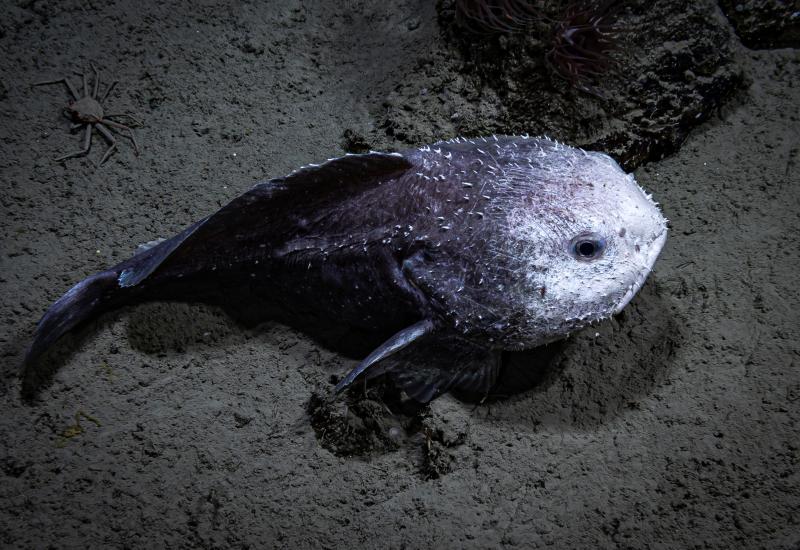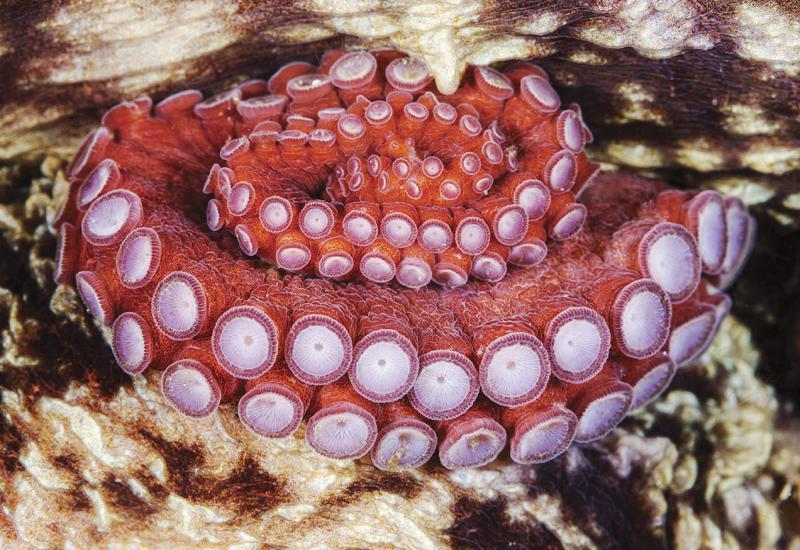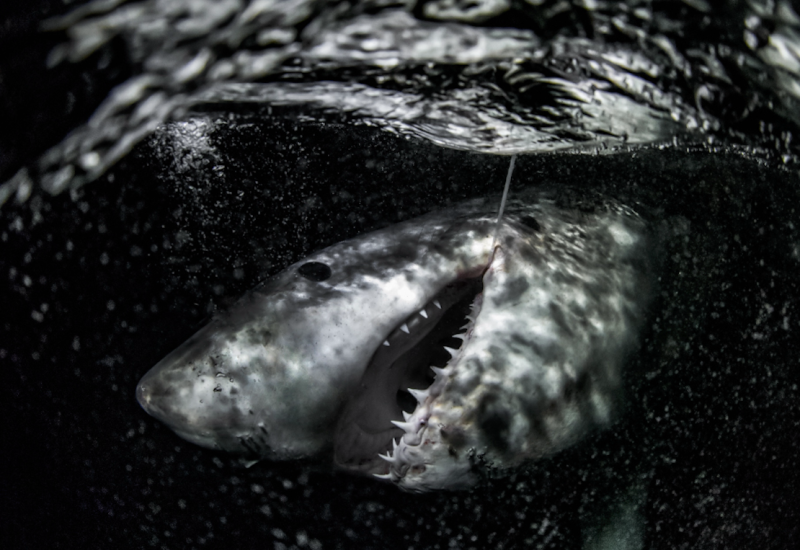Great Hammerheads: A Photo Gallery
As someone who loves and is fascinated by sharks, having a chance to be in the water with one is always an honor. Like almost everyone who dives with sharks — or dives at all — I have my “special encounter” list, the creatures I hope I will some day have the chance to be in the water with. But one shark, the great hammerhead (Sphyrna mokarran), remained elusive.
In 2010, I was on a shark expedition in the Bahamas, specifically looking for great hammerheads. The sea was rough, and diving was difficult at best. I encountered tigers, bulls, Caribbean reef and lemon sharks— no hammers. Over the next couple of years, several friends also had tried for great hammers, and all came home without a single photo or second of video, let alone a sighting.
Then, in 2012, rumors began circulating that great hammers were regularly being seen in the Bimini area, and in shallow waters. I was invited to join a small exploratory expedition to try our luck again.
Soon enough, eight very excited and hopeful people set out to experience this encounter.
We dropped anchor in about 40 feet of clear aqua water. All eyes began scanning. After about two hours of staring and bantering, the long-awaited shout “HAMMER!” finally came. The mythical fish was here. Daylight was fading, and everyone wanted to get in the water. But due to their skittish reputation, we didn’t want to scare the shark away by overwhelming her with all of us in the water at once, blasting her with strobes. We chose to respect her space and dive in small, two-person groups, shooting only natural light — no strobes — hoping the shark would get comfortable with our presence. We drew straws — I drew the short straw. I would have to wait a little longer to meet this majestic creature.
The first group of divers quietly entered the water and headed for the bottom. As the rest of us watched from the stern, we wondered, what would the shark do? Would she stay or disappear? As the divers settled in, the shark kept her distance, not sure what these noisy, alien bubble-blowing things were that had just entered her world. Yet little by little, she came closer.
Initially, as she approached you could see her posture change. She would go from a “normal” level swimming posture on the bottom to a slightly sideways rolled position several feet off the bottom, leaning away from the divers. I took this as a defensive posture, one that would allow her to flee in a hurry if necessary. She repeated this several times, closing the gap a little more each time. Her next pass was right next to the divers.
Finally, it was my turn. Camera in hand, I dropped in and settled as calmly and quietly as I could. Then I saw her, and she was heading right for me, gliding by within 5 feet. I kept my camera down, just wanting to watch. She was beautiful. I observed her for several more passes, amazed at how graceful and agile she was. I raised my camera and waited for the next pass. As if on cue, she came back. A few casual tail beats brought her nice and close. I must have had my biggest smile ever as I pressed the shutter. As our time was up, I gave a very reluctant kick towards the surface. I couldn’t have scripted a better first dive with a great hammerhead.
We had four more days of diving and each dive was amazing. There were two very distinctive frequent visitors. The first we named Megan, a big, bold female. She was always the first to greet us and extremely photogenic. There were no problems getting close-ups of Megan. Ella was the other “regular.” She is missing the tops of her dorsal and caudal fins. She wasn’t as bold or big as Megan, but she warmed up to us after a couple of scouting passes. Several dives had multiple great hammers — on one dive there were six at one time.
Other visitors arrive
We also had several stingrays join our shoots, which made for some cautious moments — the rays seemed to always be in the way of getting or setting up for a shot. More than once I found myself almost kneeling on a ray, or leaning on one. I thought for sure I’d end up getting stung, but despite the very close calls, the stingrays were well behaved. With a mix of predator and prey, I never saw any predation attempts by the hammers on the rays even when they were both swimming in the same spot.
I did however have a very unexpected experience with a different spiny critter. On one of our dives, we had a lionfish come wandering up. The fish decided it would take shelter under me — there’s nothing like having an agitated (all spines erected) lionfish under your chest. My buddy and I took turns trying to stab the fish. Our actions got a lot of attention from the hammerhead that was with us, as the shark got very in tune to what we were doing. Finally my buddy stabbed the fish and got it out from under me. He shook the lionfish off of his knife. As the wounded fish tried swimming back to the sand, the hammerhead moved right in on the fish and swallowed it with several quick bites. My buddy and I looked at each other in amazement. It all happened so fast I never had a chance to get a single picture.
In addition to the daytime diving, we made several night dives. Like many night dives, this proved a little more challenging than the daytime dives. Currents picked up which brought the visibility down and backscatter up. Most of the sharks tended to not like the bright lights. Some of the sharks would tolerate the strobes, but only in very limited use. Despite the challenges, the night dives all went very well. While I can’t confirm this, I believe the images and video that came from our first night diving with the great hammerheads may be the first widely published. Our third night of diving was our last dive for the trip. As the last person got back on the boat, we stowed our gear and began the return trip back to Florida.
Concern for the future
As I look back at that trip, I worry that diving with great hammerheads in this location could become detrimental to the location and the sharks. It’s no secret that the great hammerheads have been there, and we weren’t the first to dive with them in this location. But the word of this being an easy place to dive with great hammerheads spread like wild fire after our expedition. I just hope that this little piece of shark-diving paradise stays respected and that it doesn’t turn into another rodeo spot. The numerous shark-diving operators that are sure to frequent this area must all do their part to treat the area and the sharks with the utmost deference and care. If that is not done, the sharks will certainly move out, and we will all lose the chance to spend time with one of the ocean’s most unique creatures.
As a guest to this area, or any location for that matter, we should all do our part to support the area’s and communities that we dive in and around. When you’re done diving, head into town and spend some time with the locals and support the local economy. Have some drinks and food away from your boat and get to know the people whose home you are visiting. You never know, they may clue you into a little secret that may just make your next dive as unforgettable as these were for me.
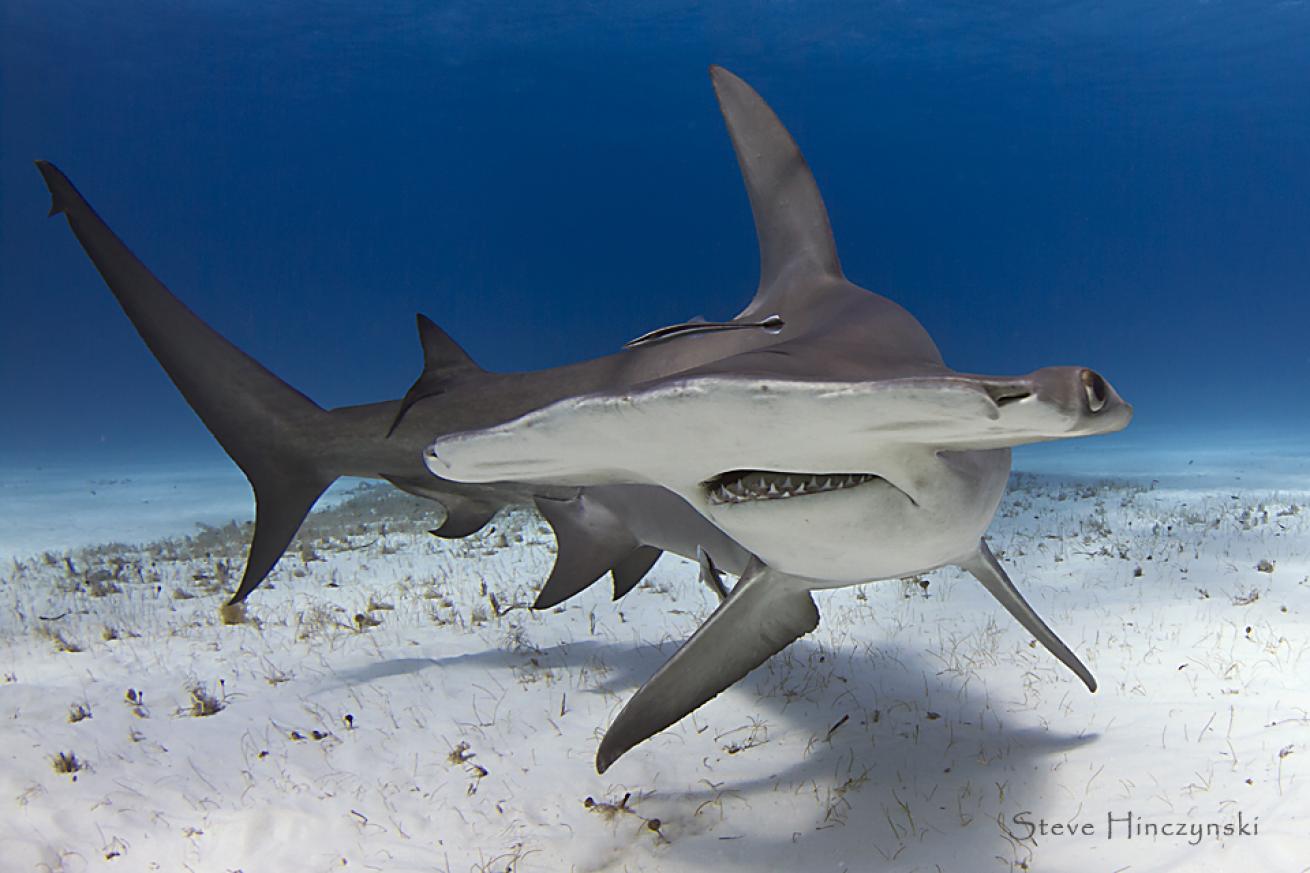
Steve HinczynskiAfter hours of quietly waiting, Steve Hinczynski was able to dive with and photograph this great hammerhead in Bimini.
As someone who loves and is fascinated by sharks, having a chance to be in the water with one is always an honor. Like almost everyone who dives with sharks — or dives at all — I have my “special encounter” list, the creatures I hope I will some day have the chance to be in the water with. But one shark, the great hammerhead (Sphyrna mokarran), remained elusive.
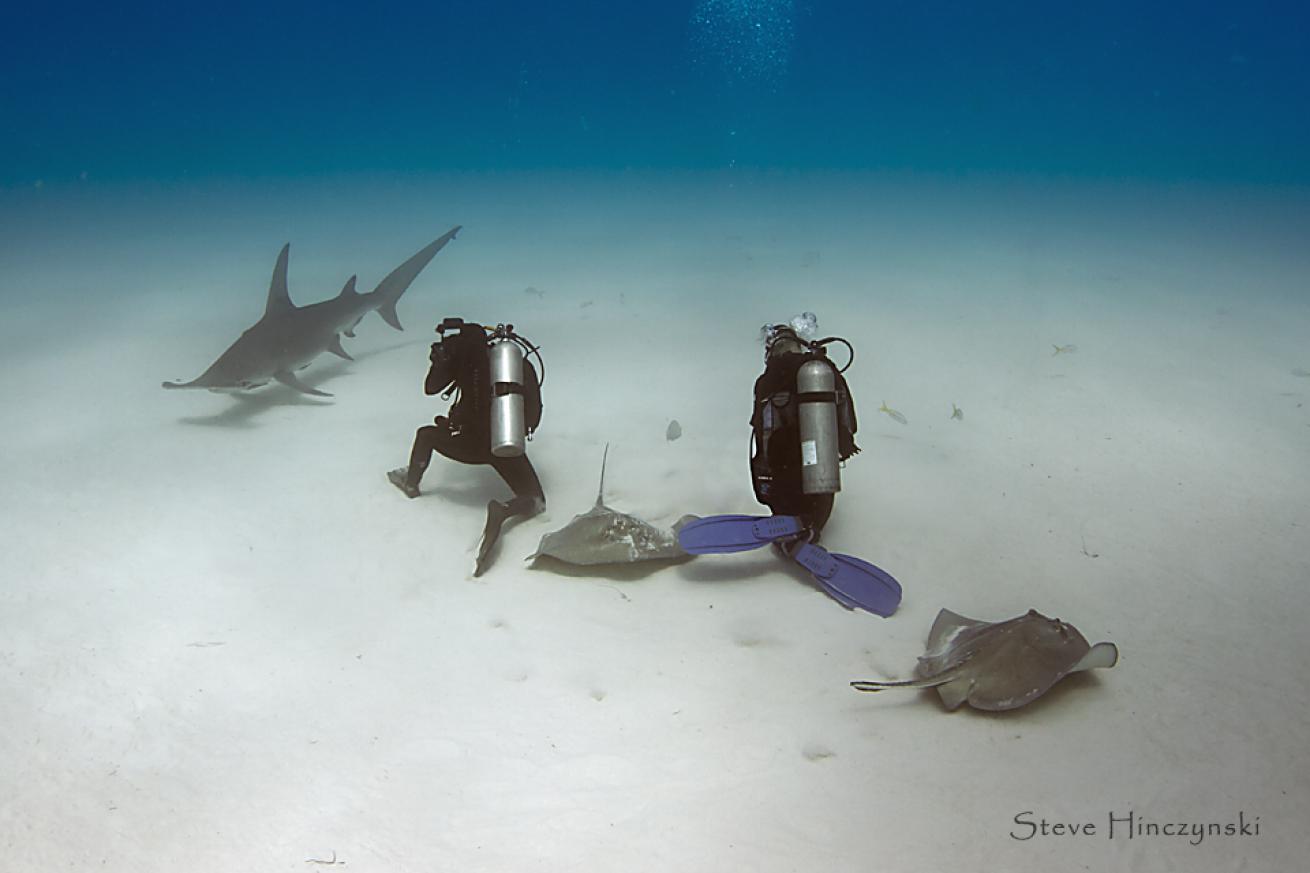
Steve HinczynskiSeveral stingrays joined the divers and the great hammerhead. While the rays seemed to always get in the way of the shot, they remained well behaved during the dive.
In 2010, I was on a shark expedition in the Bahamas, specifically looking for great hammerheads. The sea was rough, and diving was difficult at best. I encountered tigers, bulls, Caribbean reef and lemon sharks— no hammers. Over the next couple of years, several friends also had tried for great hammers, and all came home without a single photo or second of video, let alone a sighting.
Then, in 2012, rumors began circulating that great hammers were regularly being seen in the Bimini area, and in shallow waters. I was invited to join a small exploratory expedition to try our luck again.
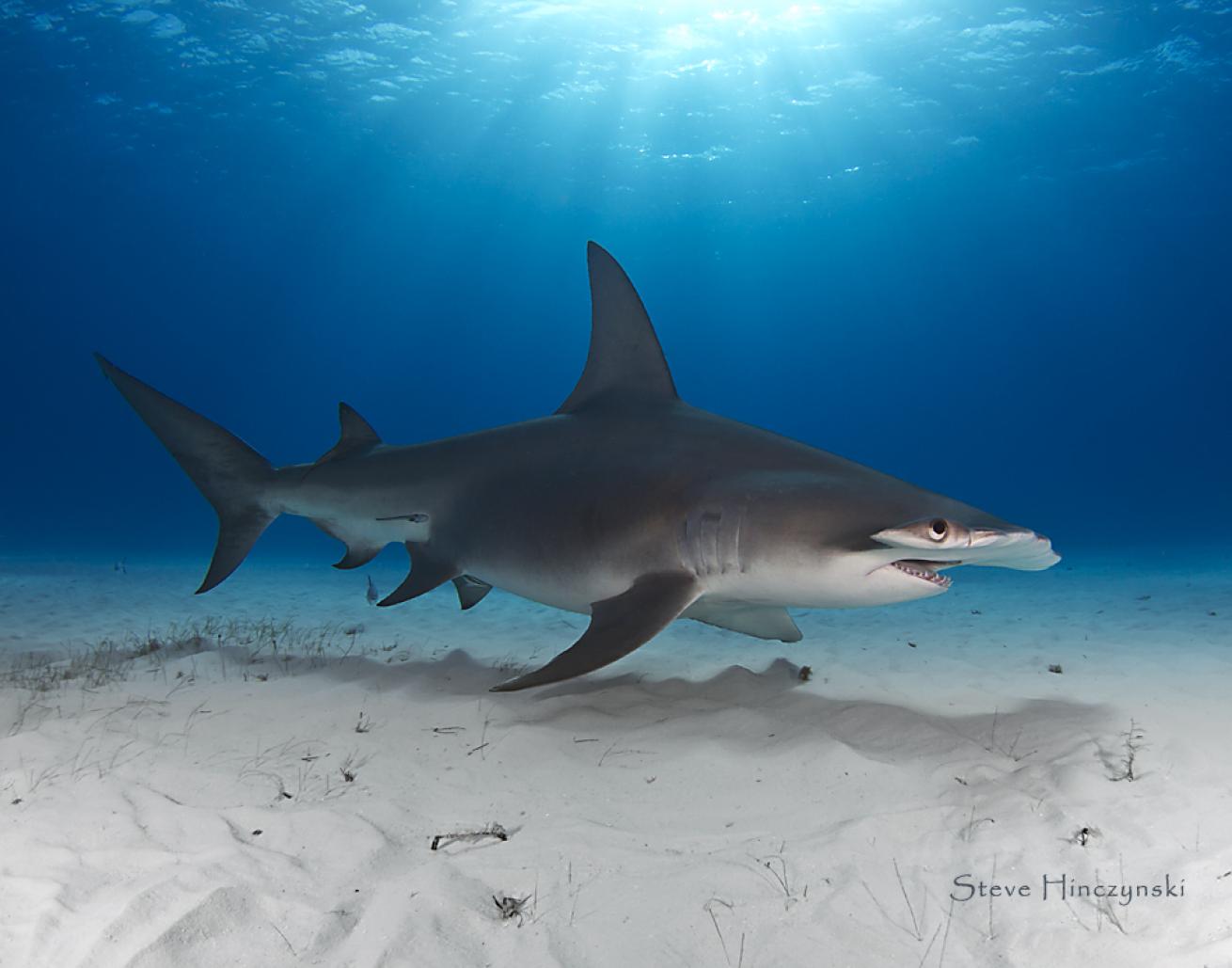
Steve HinczynskiPhotographer Steve Hinczynski said he was amazed by the grace of the great hammerhead shark.
Soon enough, eight very excited and hopeful people set out to experience this encounter.
We dropped anchor in about 40 feet of clear aqua water. All eyes began scanning. After about two hours of staring and bantering, the long-awaited shout “HAMMER!” finally came. The mythical fish was here. Daylight was fading, and everyone wanted to get in the water. But due to their skittish reputation, we didn’t want to scare the shark away by overwhelming her with all of us in the water at once, blasting her with strobes. We chose to respect her space and dive in small, two-person groups, shooting only natural light — no strobes — hoping the shark would get comfortable with our presence. We drew straws — I drew the short straw. I would have to wait a little longer to meet this majestic creature.
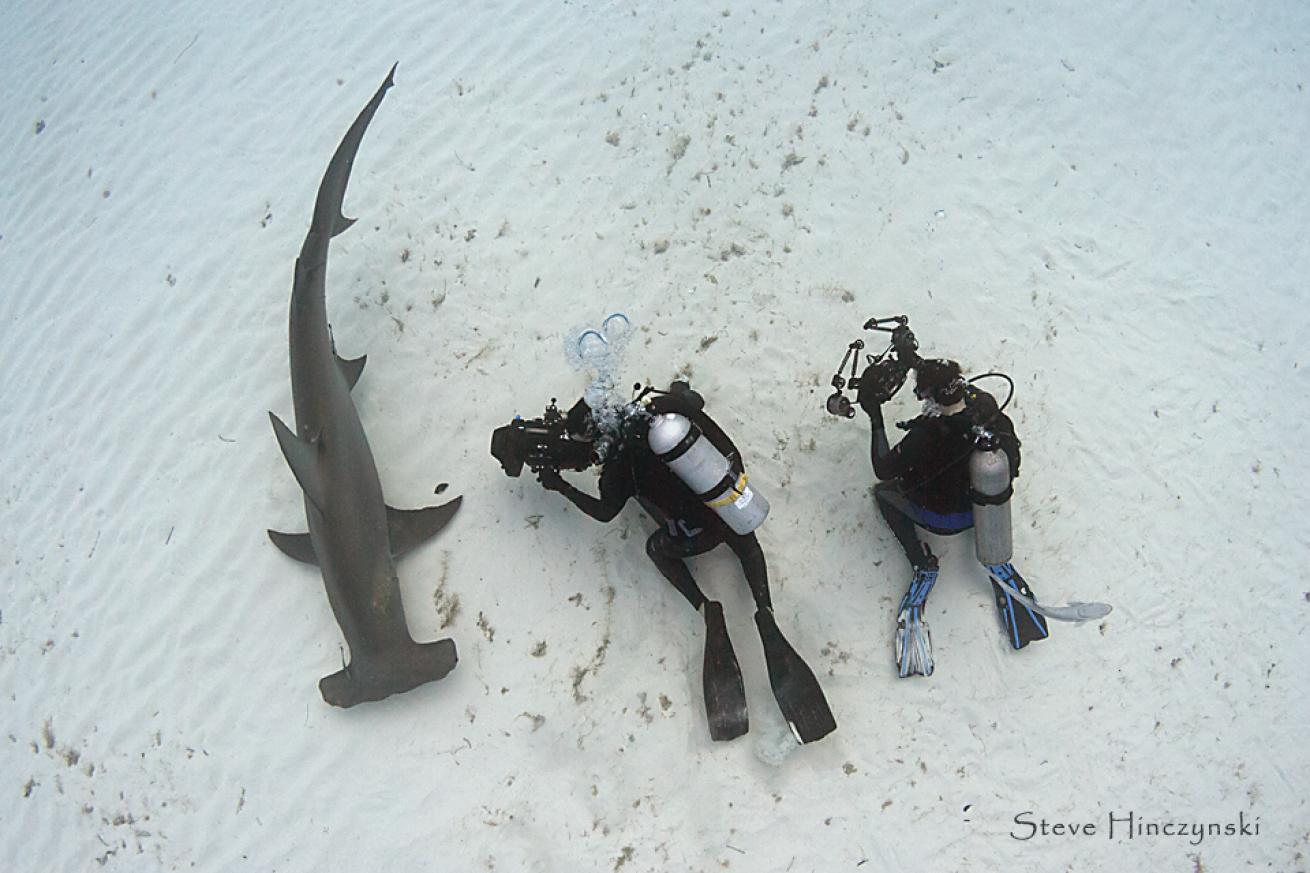
Steve HinczynskiThe divers chose to respect the skittish shark's space and approached the great hammerhead in two-person groups.
The first group of divers quietly entered the water and headed for the bottom. As the rest of us watched from the stern, we wondered, what would the shark do? Would she stay or disappear? As the divers settled in, the shark kept her distance, not sure what these noisy, alien bubble-blowing things were that had just entered her world. Yet little by little, she came closer.
Initially, as she approached you could see her posture change. She would go from a “normal” level swimming posture on the bottom to a slightly sideways rolled position several feet off the bottom, leaning away from the divers. I took this as a defensive posture, one that would allow her to flee in a hurry if necessary. She repeated this several times, closing the gap a little more each time. Her next pass was right next to the divers.
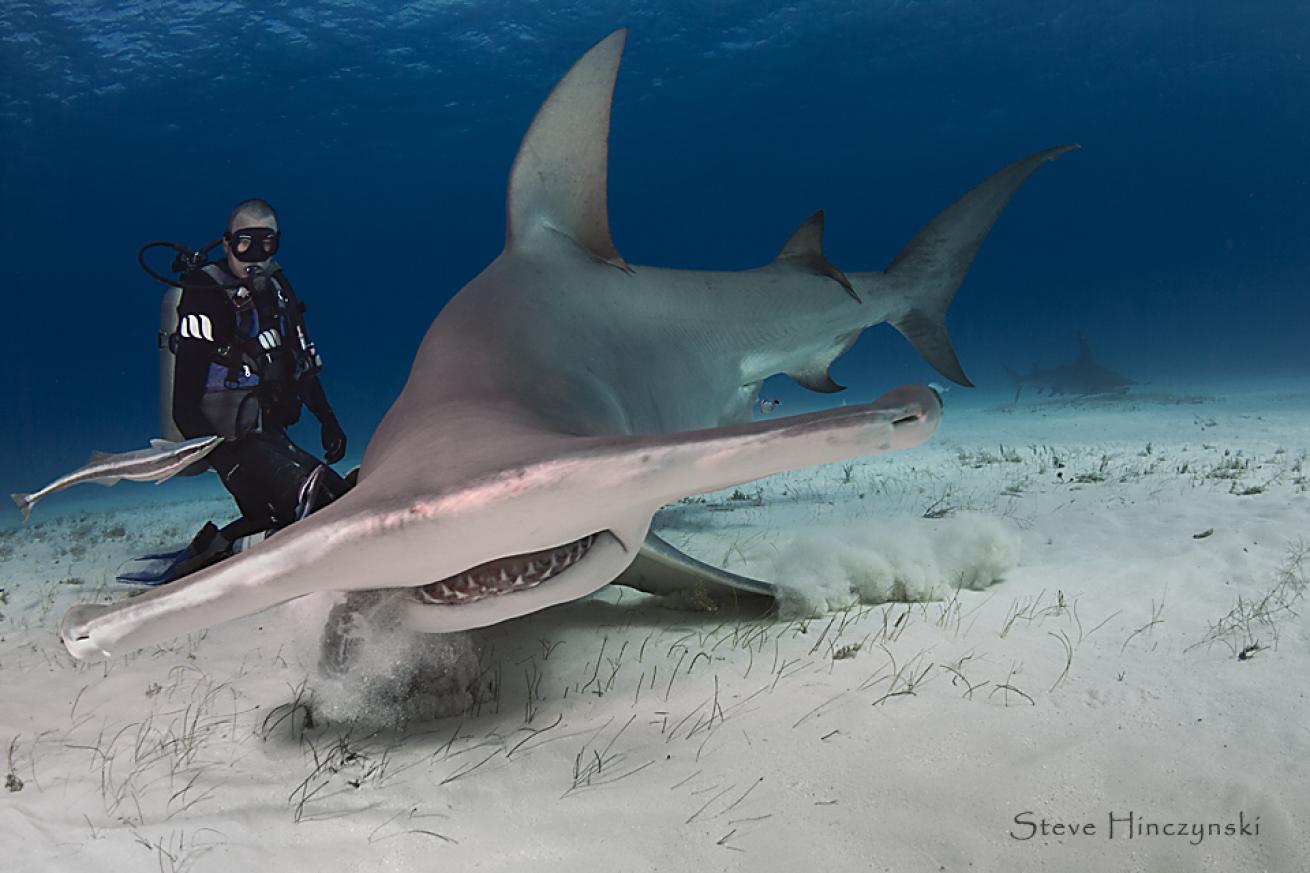
Steve HinczynskiFive days of diving with great hammerheads in Bimini saw repeat sharks, along with new ones, each day.
Finally, it was my turn. Camera in hand, I dropped in and settled as calmly and quietly as I could. Then I saw her, and she was heading right for me, gliding by within 5 feet. I kept my camera down, just wanting to watch. She was beautiful. I observed her for several more passes, amazed at how graceful and agile she was. I raised my camera and waited for the next pass. As if on cue, she came back. A few casual tail beats brought her nice and close. I must have had my biggest smile ever as I pressed the shutter. As our time was up, I gave a very reluctant kick towards the surface. I couldn’t have scripted a better first dive with a great hammerhead.
We had four more days of diving and each dive was amazing. There were two very distinctive frequent visitors. The first we named Megan, a big, bold female. She was always the first to greet us and extremely photogenic. There were no problems getting close-ups of Megan. Ella was the other “regular.” She is missing the tops of her dorsal and caudal fins. She wasn’t as bold or big as Megan, but she warmed up to us after a couple of scouting passes. Several dives had multiple great hammers — on one dive there were six at one time.
Other visitors arrive
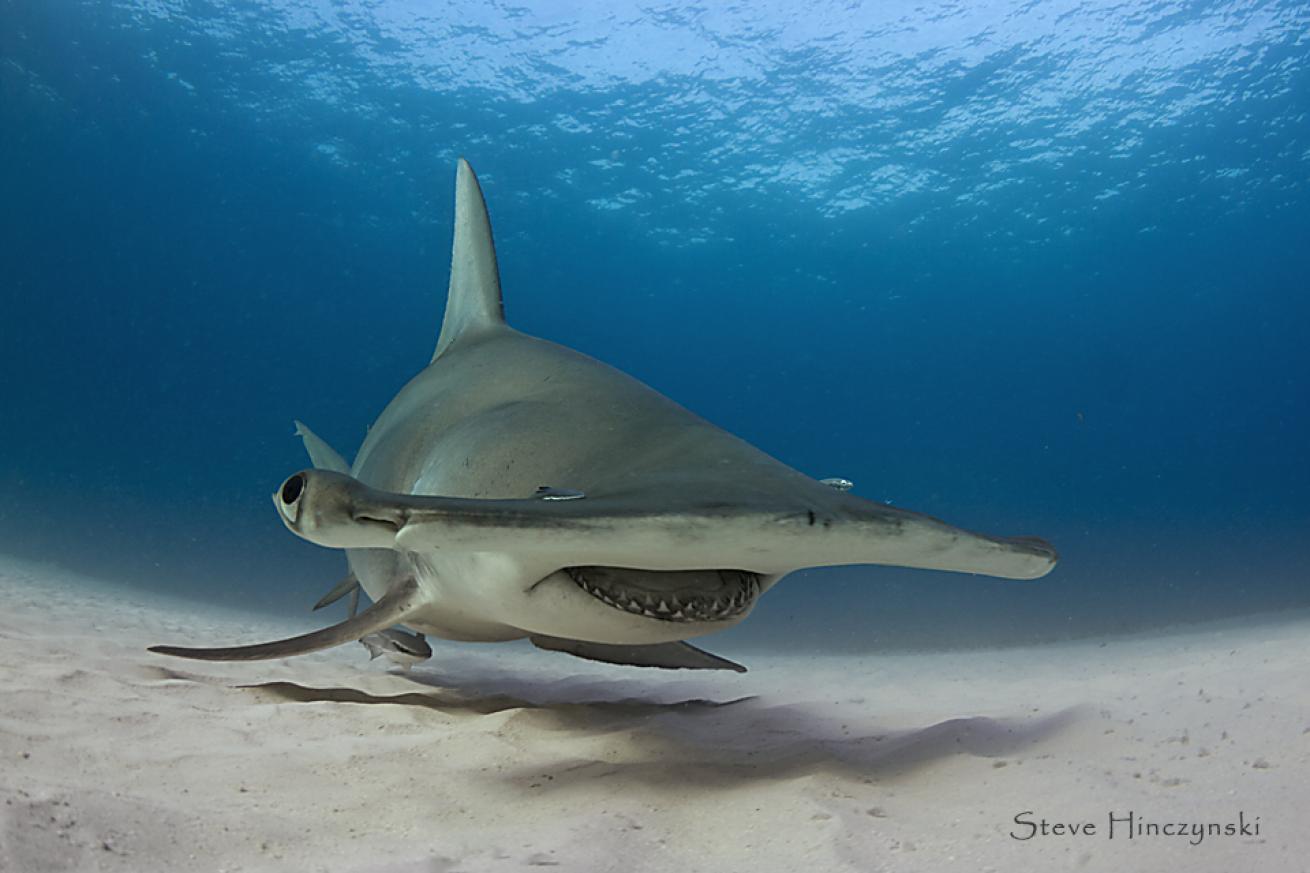
Steve HinczynskiAfter many cautious passes, the great hammerhead shark swims directly toward photographer Steve Hinczynski.
We also had several stingrays join our shoots, which made for some cautious moments — the rays seemed to always be in the way of getting or setting up for a shot. More than once I found myself almost kneeling on a ray, or leaning on one. I thought for sure I’d end up getting stung, but despite the very close calls, the stingrays were well behaved. With a mix of predator and prey, I never saw any predation attempts by the hammers on the rays even when they were both swimming in the same spot.
I did however have a very unexpected experience with a different spiny critter. On one of our dives, we had a lionfish come wandering up. The fish decided it would take shelter under me — there’s nothing like having an agitated (all spines erected) lionfish under your chest. My buddy and I took turns trying to stab the fish. Our actions got a lot of attention from the hammerhead that was with us, as the shark got very in tune to what we were doing. Finally my buddy stabbed the fish and got it out from under me. He shook the lionfish off of his knife. As the wounded fish tried swimming back to the sand, the hammerhead moved right in on the fish and swallowed it with several quick bites. My buddy and I looked at each other in amazement. It all happened so fast I never had a chance to get a single picture.
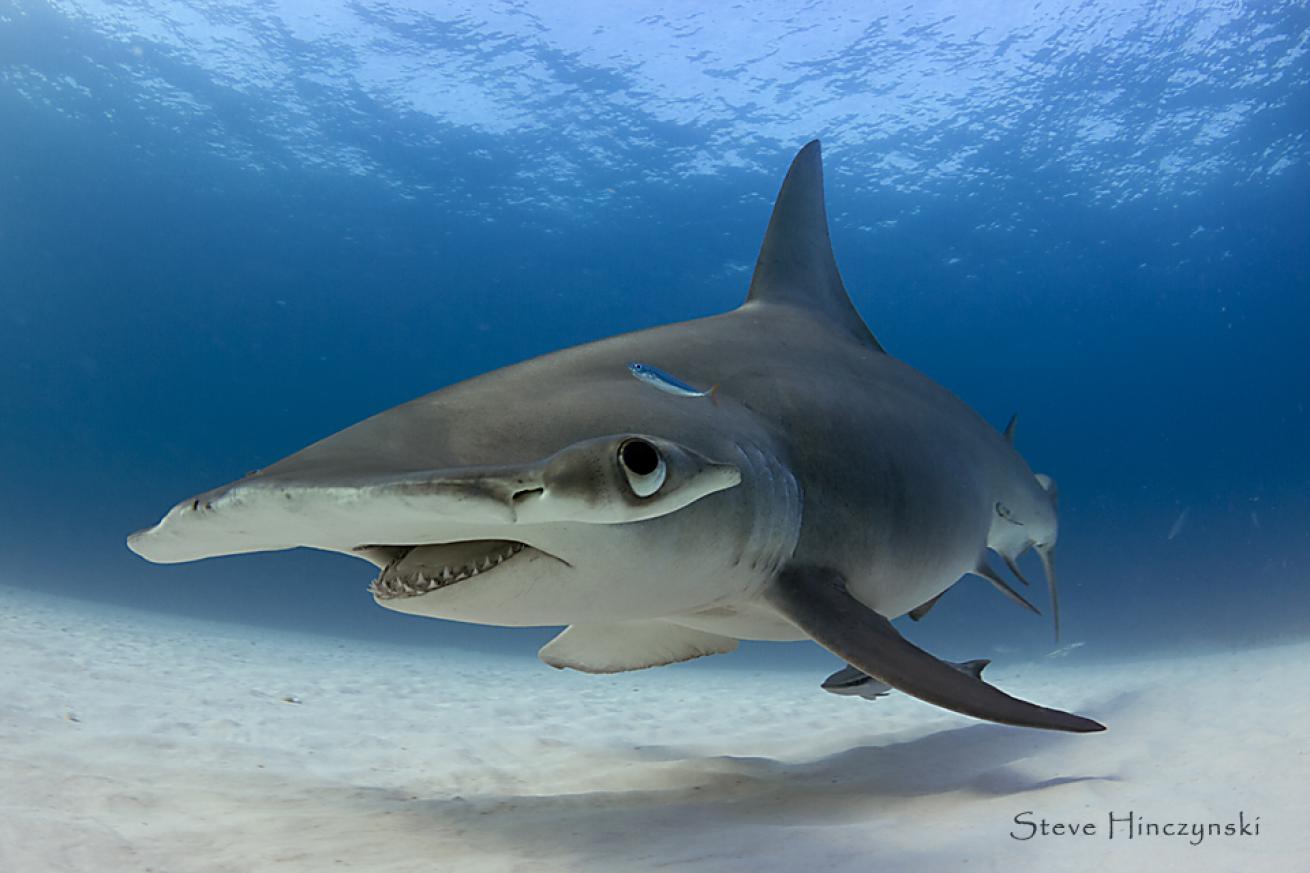
Steve HinczynskiDiving with the great hammerhead shark had great visibility in the clear blue water, just 40 feet down.
In addition to the daytime diving, we made several night dives. Like many night dives, this proved a little more challenging than the daytime dives. Currents picked up which brought the visibility down and backscatter up. Most of the sharks tended to not like the bright lights. Some of the sharks would tolerate the strobes, but only in very limited use. Despite the challenges, the night dives all went very well. While I can’t confirm this, I believe the images and video that came from our first night diving with the great hammerheads may be the first widely published. Our third night of diving was our last dive for the trip. As the last person got back on the boat, we stowed our gear and began the return trip back to Florida.
Concern for the future
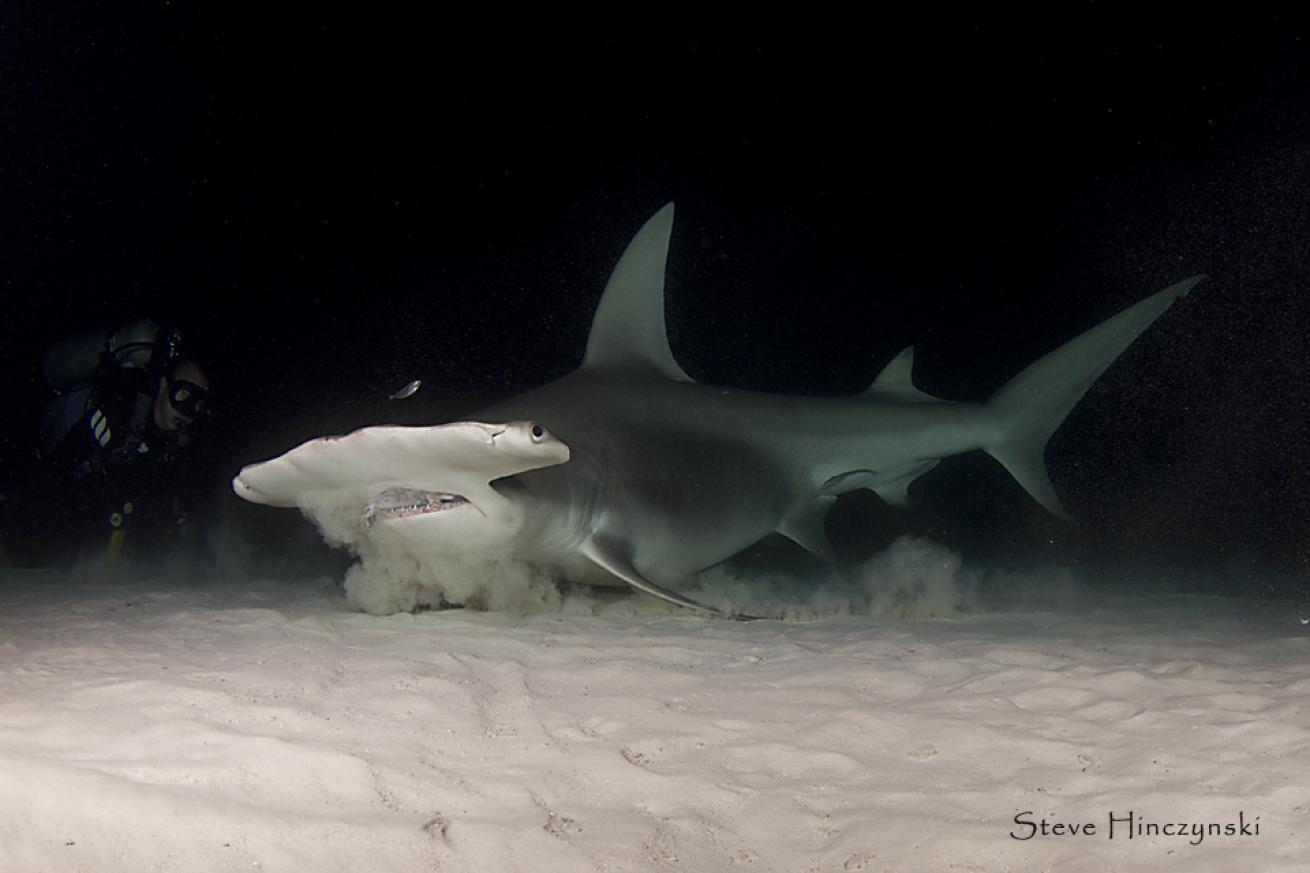
Steve HinczynskiThe night dives with the great hammerhead sharks proved challenging due to low visibility and backscatter from currents. Most of the sharks did not like the bright lights, but some were more tolerant.
As I look back at that trip, I worry that diving with great hammerheads in this location could become detrimental to the location and the sharks. It’s no secret that the great hammerheads have been there, and we weren’t the first to dive with them in this location. But the word of this being an easy place to dive with great hammerheads spread like wild fire after our expedition. I just hope that this little piece of shark-diving paradise stays respected and that it doesn’t turn into another rodeo spot. The numerous shark-diving operators that are sure to frequent this area must all do their part to treat the area and the sharks with the utmost deference and care. If that is not done, the sharks will certainly move out, and we will all lose the chance to spend time with one of the ocean’s most unique creatures.
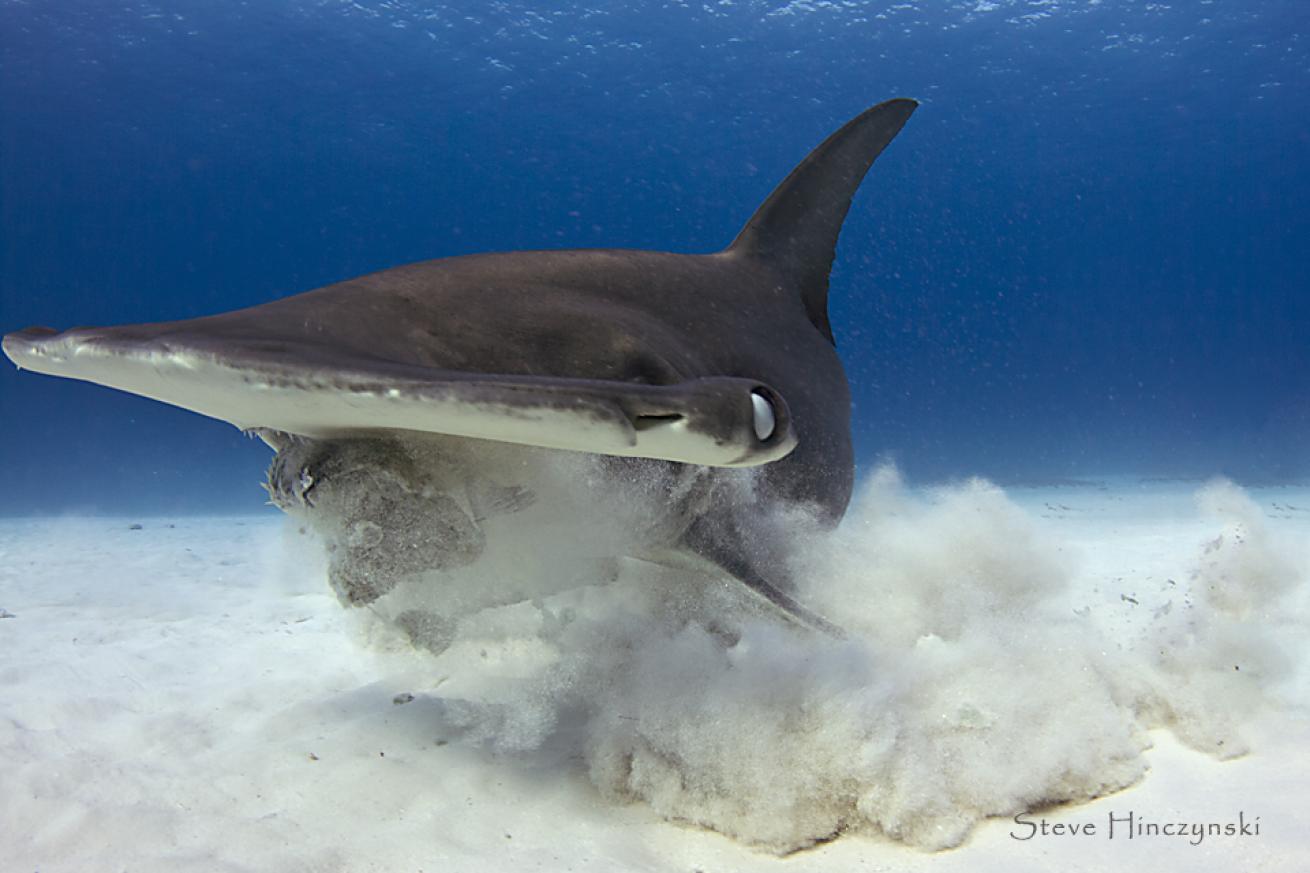
Steve HinczynskiThe great hammerhead shark in Bimini is an expert predator, but was cautious around the divers.
As a guest to this area, or any location for that matter, we should all do our part to support the area’s and communities that we dive in and around. When you’re done diving, head into town and spend some time with the locals and support the local economy. Have some drinks and food away from your boat and get to know the people whose home you are visiting. You never know, they may clue you into a little secret that may just make your next dive as unforgettable as these were for me.

